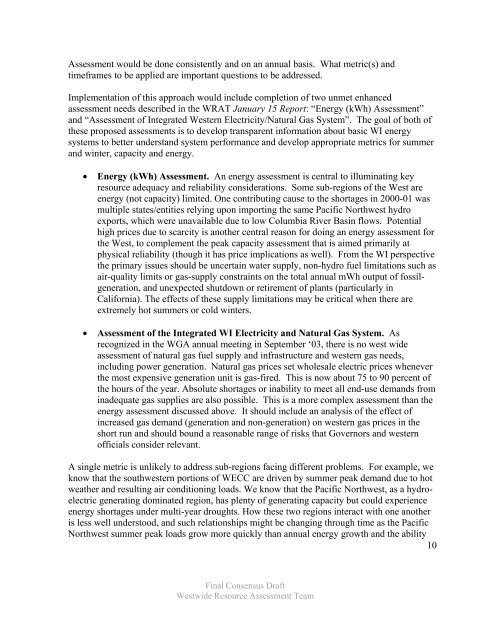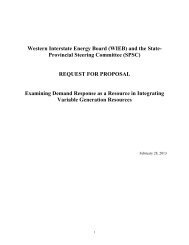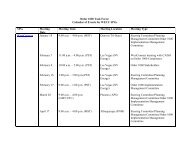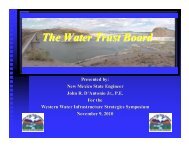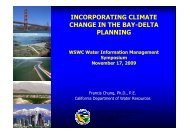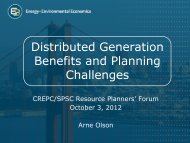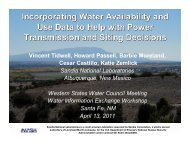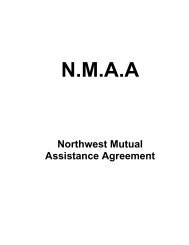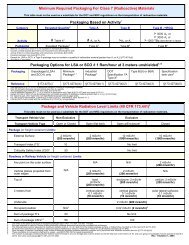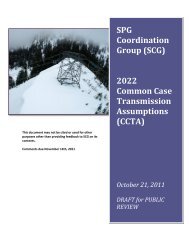WRAT Final Briefing Paper - Western Governors' Association
WRAT Final Briefing Paper - Western Governors' Association
WRAT Final Briefing Paper - Western Governors' Association
You also want an ePaper? Increase the reach of your titles
YUMPU automatically turns print PDFs into web optimized ePapers that Google loves.
Assessment would be done consistently and on an annual basis. What metric(s) and<br />
timeframes to be applied are important questions to be addressed.<br />
Implementation of this approach would include completion of two unmet enhanced<br />
assessment needs described in the <strong>WRAT</strong> January 15 Report: “Energy (kWh) Assessment”<br />
and “Assessment of Integrated <strong>Western</strong> Electricity/Natural Gas System”. The goal of both of<br />
these proposed assessments is to develop transparent information about basic WI energy<br />
systems to better understand system performance and develop appropriate metrics for summer<br />
and winter, capacity and energy.<br />
• Energy (kWh) Assessment. An energy assessment is central to illuminating key<br />
resource adequacy and reliability considerations. Some sub-regions of the West are<br />
energy (not capacity) limited. One contributing cause to the shortages in 2000-01 was<br />
multiple states/entities relying upon importing the same Pacific Northwest hydro<br />
exports, which were unavailable due to low Columbia River Basin flows. Potential<br />
high prices due to scarcity is another central reason for doing an energy assessment for<br />
the West, to complement the peak capacity assessment that is aimed primarily at<br />
physical reliability (though it has price implications as well). From the WI perspective<br />
the primary issues should be uncertain water supply, non-hydro fuel limitations such as<br />
air-quality limits or gas-supply constraints on the total annual mWh output of fossilgeneration,<br />
and unexpected shutdown or retirement of plants (particularly in<br />
California). The effects of these supply limitations may be critical when there are<br />
extremely hot summers or cold winters.<br />
• Assessment of the Integrated WI Electricity and Natural Gas System. As<br />
recognized in the WGA annual meeting in September ‘03, there is no west wide<br />
assessment of natural gas fuel supply and infrastructure and western gas needs,<br />
including power generation. Natural gas prices set wholesale electric prices whenever<br />
the most expensive generation unit is gas-fired. This is now about 75 to 90 percent of<br />
the hours of the year. Absolute shortages or inability to meet all end-use demands from<br />
inadequate gas supplies are also possible. This is a more complex assessment than the<br />
energy assessment discussed above. It should include an analysis of the effect of<br />
increased gas demand (generation and non-generation) on western gas prices in the<br />
short run and should bound a reasonable range of risks that Governors and western<br />
officials consider relevant.<br />
A single metric is unlikely to address sub-regions facing different problems. For example, we<br />
know that the southwestern portions of WECC are driven by summer peak demand due to hot<br />
weather and resulting air conditioning loads. We know that the Pacific Northwest, as a hydroelectric<br />
generating dominated region, has plenty of generating capacity but could experience<br />
energy shortages under multi-year droughts. How these two regions interact with one another<br />
is less well understood, and such relationships might be changing through time as the Pacific<br />
Northwest summer peak loads grow more quickly than annual energy growth and the ability<br />
10<br />
<strong>Final</strong> Consensus Draft<br />
Westwide Resource Assessment Team


